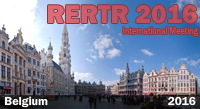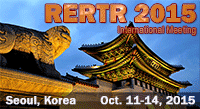Abstracts and Available Papers Presented at the
1996 International RERTR Meeting
STATUS AND PERSPECTIVES OF FRG-1 AFTER CONVERSION TO
LEU
Experiences made, Future Plans, Lessons learned especially in Spent
Fuel Management
W. Krull, W. Jager
GKSS-Forschungszentrum Geesthacht GmbH
Max-Planck-Strae
D-21502 Geestacht, Germany
ABSTRACT
Already in the 1980's GKSS Research Center Geesthacht, Germany, decided to terminate operation of its two research reactors on the HEU fuel cycle. This decision was made in acknowledgment of the aims of the RERTR program, of which GKSS was from the beginning a strong supporter.
The FRG-2 (15 MW) was scheduled to stop operation in 1991 for lack of scientific/technical interest for future use. Therefore conversion to LEU was not considered reasonable. The FRG-1 (5MW) has been converted in February 1991 from HEU (93%) to LEU (20%) in one step. Before converting the FRG-1, a variety of new fuel elements including 45% enriched fuel (1,4 g U/cc), U3O8 fuel with 3,1 g U/cc and prototype fuel elements of U3Si2 with a fuel loading of 3,7 g U/cc have been successfully tested and inspected. After performing all these tests with excellent positive results a safety report has been written, submitted to the licensing authority and examined by consultants of the licensing authority. The license has been granted and the conversion could be made. In combination with the conversion from HEU fuel elements (93%, 180 g U-5, 0,44 g U/cc) to LEU fuel elements (20%, 323 g U-5, 3,7 g U/cc) a reduction on the core size has been made to increase the neutron flux in the beam tubes and especially at the location of a cold neutron source (which is since 1989 very successfully in operation) by approximately a factor of two. The core size has been reduced from approximately 49 HEU fuel elements to 26 LEU fuel elements.
To prepare the FRG-1 for efficient future use considerations and first calculations have been performed to reduce the core size again from 26 fuel elements to 12 fuel elements. To achieve this reduction the fuel loading has to be increased from 3,7 g U/cc to 4,8 g U/cc. in combination with other measures to be taken the thermal flux will be increased to 15 1013 n/cm2sec at the beam tube position (e.g. the location of the cold neutron source).
From the operation of the FRG-1 and FRG-2 many spent HEU and LEU fuel elements are still at the reactor site. The activities made by the GKSS research center within the last years and especially in 1996 to solve the back end problem will be reviewed. GKSS envisages to operate the FRG-1 at least until the year 2010. to keep this important neutron source at a high level of interest for the scientific community GKSS will make all efforts to improve technical performance of the reactor and to further develop the experimental facilities supplied with neutrons from the FRG-1.
![]() PDF version NOT available
PDF version NOT available
An electronic copy of the full paper is not available at this time. If you would like
to receive a copy of this paper, please contact the author.
Contact:
Wilfried Krull
GKSS GmbH
Postfach 1160
D-21494 Geesthacht, Germany
Telephone: +49-(0)4152-87-1200
Fax: +49-(0)4152-87-1338
E-mail: [email protected]




